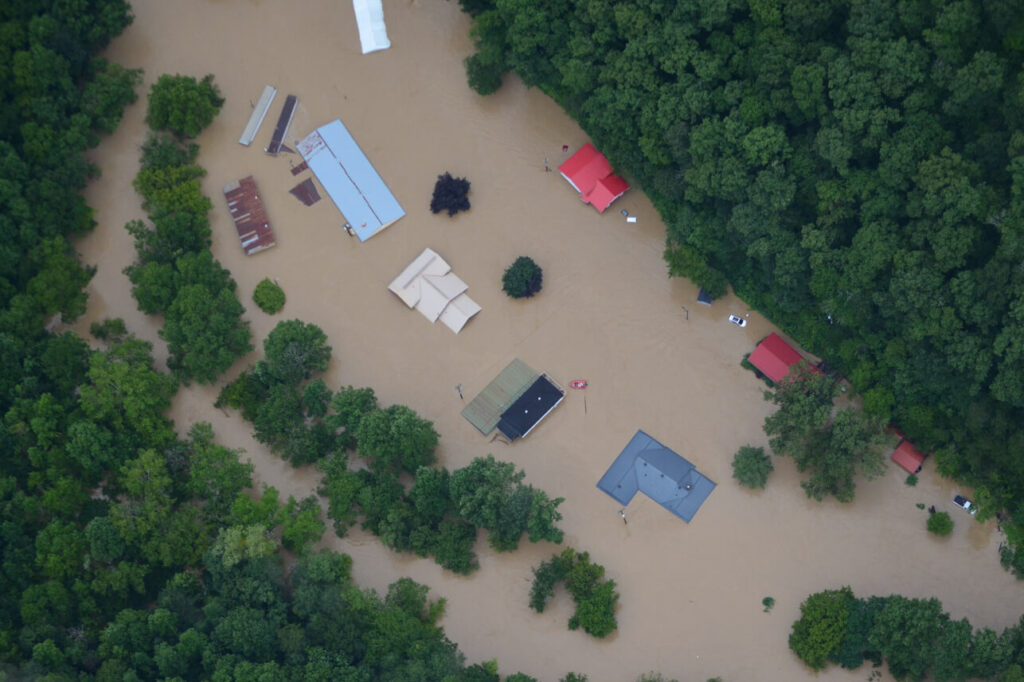It’s time to break the cycle of flooding and poverty
We can give communities the tools they need to lift themselves out of poverty.

This opinion piece originally ran in the Louisville Courier Journal on August 2, 2022.
I remember sitting on our porch in Catlettsburg, holding my cabbage patch doll watching the torrential downpour and continuously glancing at Shopes Creek as its waters crept nearer and nearer to our home.
I remember the putrid smell after a flood and the way mud hung around for weeks and weeks climbing up our legs. I remember the critters upended from their homes and into basements across the region that kept children away from those parts of the house in perpetuity.
I remember my Granny talking about the flood of 1977 and how the scars of that one flood alone completely shaped – and still shapes – the story of the community as a floodwall was built to divorce people from the river, but also from the water, which was the lifeblood of the neighborhood.
Communities like mine and those flooded out in the last few weeks, live these realities constantly. And it’s just getting worse as climate change fuels increasingly severe storms and floods. In 2020, the U.S. saw an average annual loss of $32 billion from flooding, and that cost could rise by up to $41 billion by 2050, according to a study published in Nature. Low-income, Black, Latino and Indigenous communities are disproportionately impacted. Flooding has always kept people in poverty and that will just get worse, unless we take action.
My heart aches for my neighbors, but I have hope. Because even while rivers are where we’re feeling the devastation right now, rivers are also the source of powerful, equitable, cost-effective solutions.
There are proven ways to keep people and property safe along rivers, while reaping all of the benefits a healthy river offers. We can restore floodplains (the low-lying areas along rivers) and wetlands, giving rivers room to safely accommodate floodwaters. We can improve land use and change how we build, so runoff doesn’t overwhelm downstream communities. We can also help people get out of harm’s way− in some regions of the U.S., communities have successfully relocated to higher ground.
It’s critical that every community understands their options, can advocate for their own safety and well-being and determine their future. That is why American Rivers is calling on the Biden administration to take emergency climate actions in support of healthy rivers. Here are three steps the administration can take right now to support hometowns like mine and other vulnerable communities nationwide:
Help people find safety
The administration should require FEMA and HUD to better integrate programs for affordable housing with floodplain management to meet the housing needs of people who need to relocate to safer ground. The lack of resilient affordable housing remains a huge barrier for families looking to move away from flood prone areas. The need for climate-resilient, affordable housing is critical to frontline communities as they recover from and prepare for extreme weather.
Send resources to vulnerable communities
The administration can help states improve flood management, both reducing flood damage − particularly for disadvantaged communities − and protecting and restoring natural floodplains. We must reduce the gap in FEMA resource availability for low-income communities of color, which often don’t have the municipal staff required to be eligible for pre disaster mitigation programs.
Protect and restore rivers
The administration should establish a National Floodplain Protection and Restoration Program to better use federal floodplain management programs to protect and restore the nation’s floodplains as carbon sinks and reduce flood damages. The initiative should set national goals for protection and restoration for floodplains, coordinate floodplain data collection, create mapping and prioritization tools and equitably distribute flood resilience funding to states.
We can break the devastating cycle of flood damage. We can give communities the tools they need to lift themselves out of poverty. We can create a future where healthy rivers and people thrive together.




2 responses to “It’s time to break the cycle of flooding and poverty”
Changing thought processes from traditional fewpoints toward the asthedics of dams, to a concern for their negative impact on a community and surrounding environment, is too often a tough nut to crack.
Change is hard for many people. However, our human race is dependent upon change, if we desire to continue a forward movement; as apposed to dieing in our footsteps.
Sustainably Clean Water, is our viable path forward.
Great article! We can work WITH the river instead of against it to solve many of these social, environmental, and economic challenges.